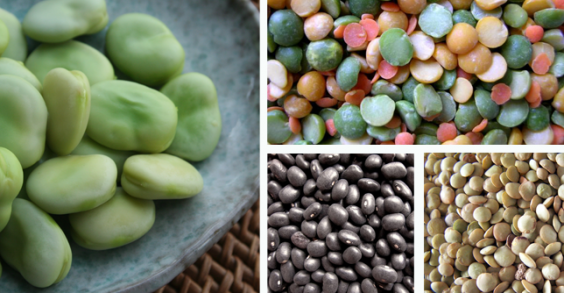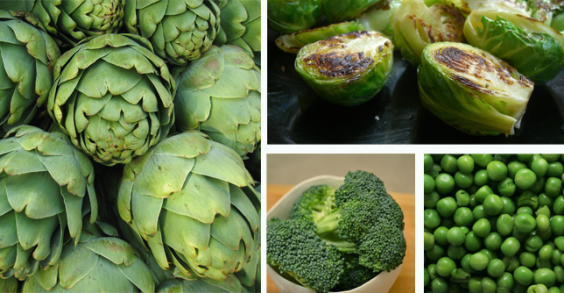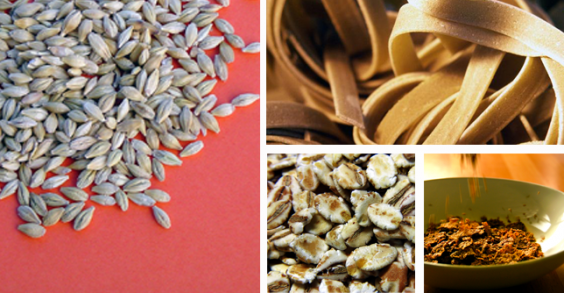Quinoa, 3/4 c is 3.75 g fiber
Oatmeal, 3/4 c is 3 g fiber
Toast (if I had double fiber bread) 5-6 g per slice
Flax seed, 1 T is 1.9 g fiber
Strawberries, 1 cup is 3 g fiber
I think flax seed with yogurt this morning and a half cup of strawberries.
List courtesy of greatist.com/health/surprising-high-fiber-foods
Oatmeal, 3/4 c is 3 g fiber
Toast (if I had double fiber bread) 5-6 g per slice
Flax seed, 1 T is 1.9 g fiber
Strawberries, 1 cup is 3 g fiber
I think flax seed with yogurt this morning and a half cup of strawberries.
List courtesy of greatist.com/health/surprising-high-fiber-foods
The Best High-Fiber Foods
Note: The amount of fiber in these foods can vary slightly between the raw and cooked versions.
1. Split Peas
Fiber: 16.3 grams per cup, cooked.
Go-To Recipe: Spinach and Yellow Split Pea Soup
A staple in Indian cooking, split peas form a terrific, protein-rich base for soups, stews, and dhals. This South Asian recipe is the best kind of comfort food: healthy, satisfying, and super filling.
Go-To Recipe: Spinach and Yellow Split Pea Soup
A staple in Indian cooking, split peas form a terrific, protein-rich base for soups, stews, and dhals. This South Asian recipe is the best kind of comfort food: healthy, satisfying, and super filling.
2. Lentils
Fiber: 15.6 grams per cup, cooked.
Go-To Recipe: Lentil Quinoa Burgers with Sautéed Mushrooms
Lentils are kitchen all-stars—they take less time to cook and are more versatile than many other legumes. This recipe takes advantage of their slightly meatier taste and turns them into a juicy patty that’s held together with lemon juice, cilantro, and walnuts.
Go-To Recipe: Lentil Quinoa Burgers with Sautéed Mushrooms
Lentils are kitchen all-stars—they take less time to cook and are more versatile than many other legumes. This recipe takes advantage of their slightly meatier taste and turns them into a juicy patty that’s held together with lemon juice, cilantro, and walnuts.
3. Black Beans
Fiber: 15 grams per cup, cooked.
Go-To Recipe: Black Bean and Sweet Potato Chili
Sweet potato pairs perfectly with the smokiness of chipotle peppers and adds even more fiber to this hearty bean dish. Loaded with complex carbs and protein, this cold-weather stew makes a perfect post-workout meal.
Go-To Recipe: Black Bean and Sweet Potato Chili
Sweet potato pairs perfectly with the smokiness of chipotle peppers and adds even more fiber to this hearty bean dish. Loaded with complex carbs and protein, this cold-weather stew makes a perfect post-workout meal.
4. Lima Beans
Fiber: 13.2 grams per cup, cooked.
Go-To Recipe: Leek and Lima Bean Soup with Bacon
Lima beans might sound unappetizing, but when cooked in bacon fat, paired with leeks, puréed into a soup, and topped with sour cream, they’re pretty darn delicious.
Go-To Recipe: Leek and Lima Bean Soup with Bacon
Lima beans might sound unappetizing, but when cooked in bacon fat, paired with leeks, puréed into a soup, and topped with sour cream, they’re pretty darn delicious.
5. Artichokes
Fiber: 10.3 grams per medium vegetable, cooked.
Go-To Recipe: Roasted Artichokes for Two
Packing more fiber per serving than any other vegetable, artichokes are curiously underused in most people’s kitchens (perhaps because they look a bit… prickly). Get creative and try this simple recipe with lime, garlic, and black pepper.
Go-To Recipe: Roasted Artichokes for Two
Packing more fiber per serving than any other vegetable, artichokes are curiously underused in most people’s kitchens (perhaps because they look a bit… prickly). Get creative and try this simple recipe with lime, garlic, and black pepper.
6. Peas
Fiber: 8.8 grams per cup, cooked.
Go-To Recipe: Scallops on Minted Pea Purée with Prosciutto
Puréeing veggies is a great way to squeeze extra nutrients into any meal—this recipe comes together lightning-fast and is filled with protein, omega-3s, and, of course, fiber.
Go-To Recipe: Scallops on Minted Pea Purée with Prosciutto
Puréeing veggies is a great way to squeeze extra nutrients into any meal—this recipe comes together lightning-fast and is filled with protein, omega-3s, and, of course, fiber.
7. Broccoli
Fiber: 5.1 grams per cup, boiled.
Go-To Recipe: Paleo Broccoli Fritters
This caveman-friendly dish is pretty simple. To make these fritters, just combine onion, garlic, broccoli, eggs, and almond meal. Once they hit the table, you’ll be surprised how much broccoli gets finished in one sitting.
Go-To Recipe: Paleo Broccoli Fritters
This caveman-friendly dish is pretty simple. To make these fritters, just combine onion, garlic, broccoli, eggs, and almond meal. Once they hit the table, you’ll be surprised how much broccoli gets finished in one sitting.
8. Brussels Sprouts
Fiber: 4.1 grams per cup, boiled.
Go-To Recipe: Hoisin Glazed Brussels Sprouts
Try this Asian twist on the old standard—this meal carries tones of ginger, sesame, and peanut that will keep you coming back for seconds (and maybe thirds).
Go-To Recipe: Hoisin Glazed Brussels Sprouts
Try this Asian twist on the old standard—this meal carries tones of ginger, sesame, and peanut that will keep you coming back for seconds (and maybe thirds).
9. Raspberries
Fiber: 8 grams per cup, raw.
Go-To Recipe: Raspberry, Coconut, and Oat Macaroons
Raspberries aren’t a hard sell—they’re basically nature’s candy. With the help of coconut, oatmeal, and vanilla, they make a relatively healthy dessert that pleases any palate.
Go-To Recipe: Raspberry, Coconut, and Oat Macaroons
Raspberries aren’t a hard sell—they’re basically nature’s candy. With the help of coconut, oatmeal, and vanilla, they make a relatively healthy dessert that pleases any palate.
10. Blackberries
Fiber: 7.6 grams per cup, raw.
Go-To Recipe: Blackberry Lemon Salad
Successfully mixing sweet and savory isn’t for the faint of heart, but this salad makes use of blackberries, lemon, scallions, and dill to great effect.
Go-To Recipe: Blackberry Lemon Salad
Successfully mixing sweet and savory isn’t for the faint of heart, but this salad makes use of blackberries, lemon, scallions, and dill to great effect.
11. Avocados
Fiber: 6.7 grams per half, raw.
Go-To Recipe: Chicken, Black Bean, Avocado and Radish Salad
Few foods deserve the title of “superfood” more than the avocado, which is jam-packed with vitamins, fiber, and healthy fats. Pile it on top of this low-carb, Mexican-inspired salad to add some creamy goodness.
Go-To Recipe: Chicken, Black Bean, Avocado and Radish Salad
Few foods deserve the title of “superfood” more than the avocado, which is jam-packed with vitamins, fiber, and healthy fats. Pile it on top of this low-carb, Mexican-inspired salad to add some creamy goodness.
12. Pears
Fiber: 5.5 grams per medium fruit, raw.
Go-To Recipe: Herb-Roasted Pork Tenderloin with Pears
This recipe is a simple and inexpensive way to experiment with an unusual flavor combination. Pork works well with sweeter flavors, and the high sugar content of pears makes them easy to caramelize.
Go-To Recipe: Herb-Roasted Pork Tenderloin with Pears
This recipe is a simple and inexpensive way to experiment with an unusual flavor combination. Pork works well with sweeter flavors, and the high sugar content of pears makes them easy to caramelize.
13. Bran Flakes
Fiber: 7 grams per cup, raw.
Go-To Recipe: Vanilla, Honey, and Yogurt Smoothie with Bran Flakes
Short on time? Whip up a nutritious smoothie and take breakfast to go. This shake is a healthy and delicious way to get plenty of fiberand a hefty amount of protein, all in one glass.
Go-To Recipe: Vanilla, Honey, and Yogurt Smoothie with Bran Flakes
Short on time? Whip up a nutritious smoothie and take breakfast to go. This shake is a healthy and delicious way to get plenty of fiberand a hefty amount of protein, all in one glass.
14. Whole-Wheat Pasta
Fiber: 6.3 grams per cup, cooked.
Go-To Recipe: Avocado Pesto Pasta with Peas and Spinach
With the right sauce, whole-wheat pasta is indistinguishable from itshigh G.I., white-flour cousin. Mix in avocado to add a wonderful creaminess to your pasta without using dairy.
Go-To Recipe: Avocado Pesto Pasta with Peas and Spinach
With the right sauce, whole-wheat pasta is indistinguishable from itshigh G.I., white-flour cousin. Mix in avocado to add a wonderful creaminess to your pasta without using dairy.
15. Pearled barley
Fiber: 6 grams per cup, cooked.
Go-To Recipe: Pearl Barley Risotto with Roasted Squash, Red Peppers, and Rocket
It’s not just for making beer—barley is a chewy, nutritious grain that contains more fiber than oatmeal and brown rice. It can be used in soup, salad, or tea, but try it out in this tasty risotto with seasonal fall vegetables.
Go-To Recipe: Pearl Barley Risotto with Roasted Squash, Red Peppers, and Rocket
It’s not just for making beer—barley is a chewy, nutritious grain that contains more fiber than oatmeal and brown rice. It can be used in soup, salad, or tea, but try it out in this tasty risotto with seasonal fall vegetables.
16. Oatmeal
Fiber: 4 grams per cup, cooked.
Go-To Recipe: Carrot Cake Oatmeal
With just one tablespoon of maple syrup per serving, this breakfast is a guilt-free way to indulge in the morning. Plus, it’s packed with fiber-friendly oats, carrots, and coconut.
Go-To Recipe: Carrot Cake Oatmeal
With just one tablespoon of maple syrup per serving, this breakfast is a guilt-free way to indulge in the morning. Plus, it’s packed with fiber-friendly oats, carrots, and coconut.




No comments:
Post a Comment